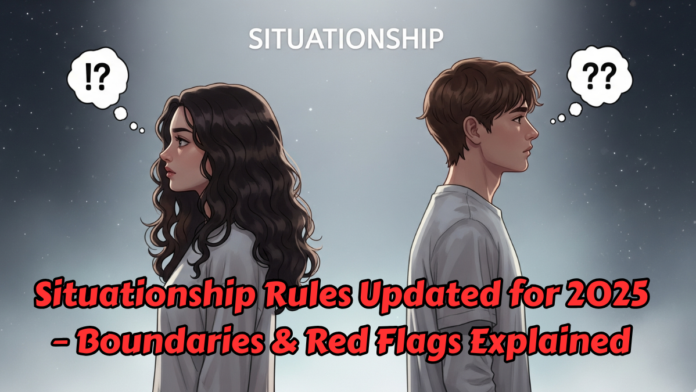Modern dating continues to evolve, and with it, the dynamics of casual relationships. Situationships—romantic connections that lack clear labels—have become increasingly common. While they offer flexibility, they also require clear boundaries to avoid emotional confusion. The updated situationship rules 2025 focus on defining expectations, recognizing red flags, and ensuring both partners maintain mutual respect.
What Defines a Situationship in 2025?
A situationship is a romantic or intimate connection that lacks formal commitment. Unlike traditional relationships, situationships prioritize emotional and physical connection without the pressure of exclusivity. However, they can become complicated if boundaries are unclear.
Key Characteristics of Situationships
- No Defined Labels: Partners avoid traditional relationship titles.
- Limited Commitment: There’s no expectation of exclusivity or long-term planning.
- Emotional Ambiguity: Feelings may develop, but clarity is often lacking.
- Casual Yet Consistent: Interaction is regular but lacks deeper commitment.
Essential Boundaries for Healthy Situationships
1. Open Communication
Clear and honest conversations are crucial. Both partners should express their expectations, emotional needs, and limits to prevent misunderstandings.
2. Mutual Respect
Regardless of the casual nature, respect is non-negotiable. Emotional manipulation, ghosting, or inconsistent behavior should be avoided.
3. Emotional Awareness
Understanding personal feelings and recognizing when the situationship no longer serves emotional well-being is essential.
4. Defined Expectations
Both individuals should agree on the level of involvement—whether it’s purely physical, emotional, or a mix of both.
5. Exit Strategy
Situationships should have an understanding of when and how to end things if one partner wants to move on.
Red Flags to Watch Out For
1. Lack of Communication
If one partner avoids discussing feelings or expectations, it can lead to emotional confusion.
2. One-Sided Effort
A healthy situationship requires mutual effort. If one person is always initiating contact or making plans, it may indicate imbalance.
3. Emotional Manipulation
Gaslighting, guilt-tripping, or inconsistent behavior are signs of an unhealthy dynamic.
4. Avoidance of Personal Growth
If the situationship prevents emotional growth or causes distress, it may be time to reconsider its value.
5. Unclear Future
While situationships are casual, there should still be clarity on whether it will evolve or remain temporary.
1. Set Personal Boundaries
Define what you’re comfortable with and communicate it clearly.
2. Recognize Emotional Needs
If deeper feelings develop, reassess whether the situationship aligns with your emotional well-being.
3. Avoid Overinvestment
Situationships should be enjoyable, not emotionally draining. Maintain balance in personal life and relationships.
4. Be Honest About Intentions
If one partner wants exclusivity while the other prefers casual dating, it’s best to address it early.
5. Know When to Walk Away
If the situationship becomes toxic or emotionally exhausting, prioritize self-care and move on.
FAQs About Situationship Rules 2025
1. Can a situationship turn into a committed relationship?
Yes, but only if both partners openly communicate and agree to transition into exclusivity.
2. How do I know if I’m in a situationship or a relationship?
Situationships lack clear labels and commitment, while relationships involve defined expectations and emotional investment.
3. What are the biggest red flags in a situationship?
Lack of communication, emotional manipulation, and one-sided effort are major warning signs.
4. How do I end a situationship respectfully?
Be honest, communicate your feelings, and ensure closure without ghosting or avoidance.
5. Is a situationship a good idea for modern dating?
It depends on personal preferences. Situationships work well for those seeking flexibility but may not suit individuals looking for long-term commitment.
Conclusion
Situationship rules 2025 emphasize clear boundaries, mutual respect, and emotional awareness in modern dating. While casual relationships offer freedom, they require honest communication and self-awareness to remain healthy. By recognizing red flags and setting expectations, individuals can navigate situationships with confidence and clarity.




